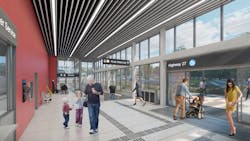Metrolinx shattering safety standards on the Finch West LRT – with glass
By modern standards, early rail stations were often poorly lit and while older stations often undergo rehabilitation, newer stations are built from the ground up with a modern design philosophy in mind – Crime Prevention Through Environmental Design (CPTED).
CPTED dictates that safety flows not only from the enforcement of laws, but from the way the environment is designed. In modern transit lines like Metrolinx's Finch West light rail transit (LRT), CPTED is seen in the expansive use of glass finishes to capitalize on the natural light.
On the Finch West LRT, both terminal underground stations and every surface stop will employ liberal use of glass as a building material, instead of more traditional non-transparent options. The structures and stops on the outside of the station – as well as the interior features like railings, elevators and elevator shafts – are made almost entirely of glass.
Why glass?
Using glass allows designers to capture the nature light, in turn maximizing visibility. With clear, unobstructed sight lines through glass panels, commuter safety is improved. From an aesthetic standpoint, glass allows more natural light to reach every area of a stop or station. Altogether, this creates an environment that is safer and more inviting.
Eric Chiasson, construction manager with Mosaic Transit Group, understands CPTED principles well, and was involved with implementing the philosophy on the Finch West LRT.
“Being directly involved in station and stop design, we understood the need to maximize transparency from the beginning. Glass was going to be instrumental in providing a safe, comfortable passenger experience,” Chiasson said.
When the Finch West LRT is complete, commuters can look forward to a bright, safe and transparent commute – thanks to glass.
